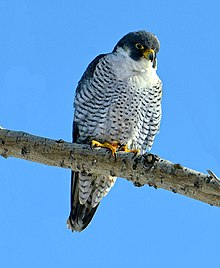Free Courses Sale ends Soon, Get It Now


Free Courses Sale ends Soon, Get It Now



Disclaimer: Copyright infringement is not intended.
Context:
Peregrines:
|
About |
It is a bird of prey (raptor) in the family Falconidae. It has a blue-grey back, barred white underparts, and a black head. It can reach over 320 km/h (200 mph) during its characteristic hunting period, making it the fastest member of the animal kingdom. |
|
Dimorphism |
They are sexually dimorphic, with females being considerably larger than males |
|
Distribution |
The peregrine's breeding range includes land regions from the Arctic tundra to the tropics. It can be found nearly everywhere on Earth, except extreme polar regions, very high mountains, and most tropical rainforests; the only major ice-free landmass from which it is entirely absent is New Zealand. |
|
Nature |
They are diurnal creatures, meaning they are active during the day. Outside the breeding season, they tend to lead solitary lives, |
|
Ecological importance |
They are apex predators and play a vital role in maintaining the balance of prey populations, particularly pigeons and doves. |
|
IUCN status |
Least Conercn |
Source:
|
PRACTICE QUESTION Q. Consider the following statements about peregrine falcons (Falco peregrinus): 1) They are primarily nocturnal creatures, preferring to hunt and be active during the night. 2) Peregrine falcons are found in every corner of the world, including extreme polar regions and tropical rainforests. 3) Females and males of the species exhibit similar sizes and physical characteristics. 4) Peregrine falcons are considered apex predators and help regulate populations of prey species such as pigeons and doves. How many of the above statement is/are correct? A.Only one B.Only two C.Only three D. All four Answer: A) |
© 2024 iasgyan. All right reserved